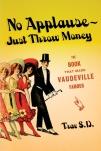I often like to say that vaudeville isn’t dead, it’s hiding in plain sight. Excellent examples of this are the Loew’s Theatre chain and MGM, the latest corporate iterations of a concern founded by Marcus Loew (1870-1927).
Of German-Jewish stock, Loew had started out as a newsie when quite a young child, and worked a successive of menial jobs until young adulthood, by which point he was managing real estate and partnered with the actor David Warfield (of the Weber and Fields company) in a variety of ventures. The pair teamed with Adolph Zukor to form the Automatic Vaudeville Company in 1903, a New York City wide chain of penny arcades, a feature of which at the time was peep machines, i,e, Kinetoscopes, early movie devices designed for solo viewing. In 1904 he founded the People’s Vaudeville Company, a chain of what Joe Laurie Jr called “store theatres”: small venues that showed one-reel films on a bill with vaudeville acts and illustrated songs. Loew began this innovation regionally in Ohio and Kentucky, but the formula rapidly proved its success and he soon brought it to New York. He and his cohorts teamed with Nick and Joe Schenck in this venture, as well as Fort George Amusement Park. The profit margin on this enterprise was not to be believed, something like 40%, and the rate expansion was dizzying. From storefronts he graduated to theatres, leased from the Shuberts, and then building his own. Sophie Tucker started out at one of his early venues, circa 1908.

(Contract from the Lambs’ collection)
By 1910, Loew had nearly two dozen theatres in NYC and was beginning to present top-of-the line prestige acts like Amelia Bingham and Lillian Russell alongside movies. Other acts who played Loew’s venues in the early days included Fred Allen (when he was still a juggler named Freddy James), Rose’s Royal Midgets, and Joe E. Brown, when he was an acrobat with the team of Rochelle and Brown. In 1919, he streamlined all of his various enterprises into Loew’s, Inc. Meantime, he gobbled up theatres and entire chains all around the country, including the Sullivan and Considine Circuit, some of Sylvester Poli’s Theatres, and the William Morris circuit.

You’d think this would mean a war with the big time combine, but Loew’s was not precisely in competition with them. Again, his chain presented a movie-and-vaudeville mix, and he paid his acts a good deal less than they got in straight vaud. Loew was not big time, but he was considered the “king of small time”, presenting shows that really weren’t small time at all, in the sense of lacking stars.

In 1921 he built Loew’s State, the chain’s Times Square flagship theatre, which we wrote about here.
At around the same time, he gathered together the Metro Pictures Corporation, the Goldwyn Picture Corporation, and Louis B. Mayer’s organization and created MGM, whose films were shown in Loew’s theatres. It’s pronounced “Lows”, by the way. Many’s the time I have encountered an old timer from New York or New Jersey who insists that it’s pronounced “Low-ee”. It’s really not. How this strange thing got started, no one knows. But take your cue from the song lyric from the 1936 show On Your Toes:
It’s two a day for Keith,
And three a day for Loew;
Pantages plays us four a day
Besides the supper show.
Unfortunately Marcus Loew died in 1927 at the age of 57, and would miss seeing MGM’s Golden Age. The Loew’s brand was in use for the theatre chain as recently as 2017. Nowadays, they go by AMC, the name of the company they merged with in 2006.
To find out more about the history of vaudeville, including Loew’s State, consult No Applause, Just Throw Money: The Book That Made Vaudeville Famous, and for more on early film read Chain of Fools: Silent Comedy and Its Legacies from Nickelodeons to Youtube.



[…] Blackbirds (1929). Only then did he go into white vaudeville, where he performed on the Keith, Loews, and Franchon and Marco circuits. He continued to perform in the presentation houses when they […]
LikeLike
[…] in to control the mobs. He was a star of radio and vaudeville in the early 30s playing the RKO and Loew’s circuits and setting records at the Palace and the Hippodrome. In 1935, he moved to England, where […]
LikeLike
[…] were begun on Sullivan and Considine properties and the house of cards collapsed. Pantages and the Loew’s chain (which by that time was national) picked up Considine’s theatres for a song. Considine […]
LikeLike
[…] variety shows at New York’s big presentation houses, the Paramount Theatre, and Loew’s State. When television came along, it was only natural for him to bring this hosting experience to the […]
LikeLike
[…] came back into the act at that point, bringing his wife and child with him. The family worked the Loews, Gus Sun, and Franchon and Marco circuits. There were so many of them that they hired their own […]
LikeLike
[…] It’s two-a-day for Keith, and three-a-day for Loew; […]
LikeLike
[…] out to Jersey City’s Journal Square (it’s not so far) to check out the Landmark Loew’s Jersey Theatre. I first became aware of the project to restore this fabulous 1929 movie palace when […]
LikeLike
[…] a tour of the Marcus Loew circuit in 1915, Brown retired from show business briefly when he learned his wife was about to […]
LikeLike
[…] small time circuits for a year, during which time she established a very important friendship with Marcus Loew, king of the small time impresarios. She performed frequently at his theatre at 116 and Lennox […]
LikeLike